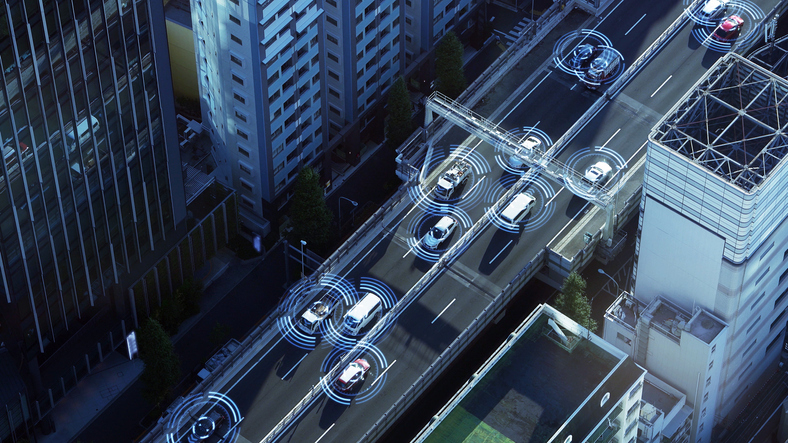In the past decade, autonomous systems have attracted the attention of many researchers and companies on a global scale. Autonomous driving systems are a key component in reaching the vision of eliminating fatal road traffic accidents. Advanced driver assist systems (ADAS) are available for highway-like situations and have been proven to reduce the frequency and severity of some traffic accidents.
To fully deploy highly automated driving technologies in more general settings, such as urban driving, the autonomous system needs to sense the surrounding environment reliably and interact with it safely. To that end, the open problems related to safe autonomous driving span from designing cost-effective, robust, and reliable sensors to developing powerful perception and motion planning and control algorithms.
In an IEEE Transactions on Control Systems Technology article, researchers propose a framework that endows the self-driving vehicle with the necessary safety guarantees. The framework ensures constraint satisfaction while tracking the reference trajectory as close as obstacles allow, resulting in safe and comfortable driving behavior.
The authors thoroughly review previous research before introducing their solution in the article. Discussing the performance and real-time capability of the framework, the researchers provide illustrative simulation examples and then demonstrate the framework’s effectiveness in experiments with an actual test vehicle.
Problem Formulation
Optimization-based techniques have proven to be a favorable choice to solve the problem of “how” self-driving vehicles should behave—the planning and controlling of vehicle motion. Model predictive control (MPC) has been commonly used since it accommodates the control of (non)linear systems that can be subject to time-varying references and (non)linear constraints.
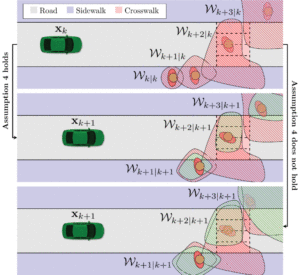
Initial predictions.
According to the authors, the objective is to design a controller for urban autonomous driving applications that allows for comfortable driving in environments where other road users are present, e.g., pedestrians, cyclists, and other vehicles.
Implementation of Safe MPC
The authors spend time discussing how the proposed framework can be applied in practice and how the safety assumptions can be enforced, showing several examples:
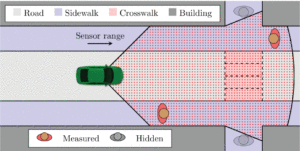
A situation where the sensor range is not able to see pedestrians behind the corner of the building.
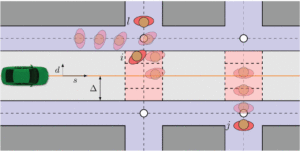
The orange line represents the vehicle’s reference path, while the black dashed lines represent the walkable road graph of the pedestrian model.
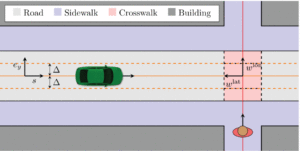
Straight road simulation setting with a crossing pedestrian blocked by the environment.
In reality, the authors note, pedestrian walking behaviors may differ depending on numerous factors (personal preferences, the environment, and the presence of other pedestrians), making future movements difficult to model in detail. More complex situations (in terms of responsibilities in case of collisions) arise when the vehicle needs to stop at a crossroad to yield to another vehicle having priority or at a crossing to yield to a pedestrian.
While the solution proposed might be oversimplified for real-world autonomous driving applications, future work will carefully evaluate whether more refined strategies are necessary. The authors note that other formulations of the safe set might be better suited for settings outside the scope of urban driving (highway driving).
Experimental Results
The researchers deployed the safe MPC controller on a full-scale Volvo XC90 T6 petrol-turbo SUV at a closed test track to verify the performance in practice.
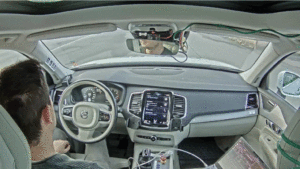
View of the test vehicle that is being controlled on a laptop computer and sending actuation requests over a network connection through OpenDLV.
The test deployed the controller in a four-way intersection with (simulated) moving pedestrians. In this setting, the vehicle needs to perform a left turn while safely avoiding any collision with moving pedestrians at two different crosswalks. While more general settings would include other road users, the test considered only pedestrians in this experiment for simplicity and to be able to illustrate the results clearly.
The results showed that a safe, real-time, capable MPC controller can be designed for urban autonomous driving applications. In particular, the results show how such an MPC framework can be formulated in practice using a safe set that always ensures robust constraint satisfaction, guaranteeing the controller's recursive safety.
As noted by the authors, future work will include investigating and verifying practical and realistic models for environment prediction (considering other road users such as cyclists and other vehicles).
View the full-text article on IEEE Xplore. Read the first page for free. Full article available with purchase or subscription. Contact us to see if your organization qualifies for a free trial.
Interested in learning more about Autonomous Driving? IEEE offers continuing education with the IEEE Guide to Autonomous Vehicle Technology Course Program.



